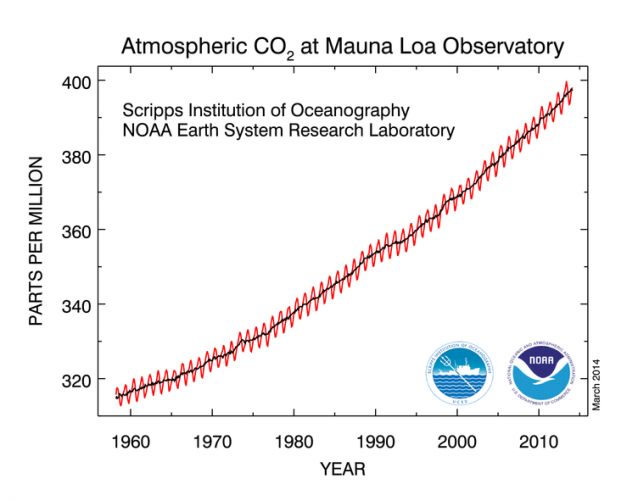The concentration of carbon dioxide, the greenhouse gas that drives climate change, hit 402 parts per million this week—the highest level recorded in at least 800,000 years.
The recordings came from the National Oceanic and Atmospheric Association's Mauna Loa Observatory in Hawaii, which marked another ominous milestone last May when the 400 ppm threshold was crossed for the first time in recorded history.

CREDIT: NOAA
Carbon dioxide (CO2) levels spike every spring but this year the threshold was crossed in March, two months earlier than last year. In fact, it’s happening “at faster rates virtually every decade,” according to James Butler, Director of NOAA’s Global Monitoring Division, a trend that “is consistent with rising fossil fuel emissions.”
400 ppm was long considered a very serious measurement but it isn’t the end — it’s just a marker on the road to ever-increasing carbon pollution levels, Butler explained in an interview on NOAA’s website. “It is a milestone, marking the fact that humans have caused carbon dioxide concentrations to rise 120 ppm since pre-industrial times, with over 90 percent of that in the past century alone. We don’t know where the tipping points are.”
When asked if the 400 ppm will be reached even earlier next year, Butler responded simply, “Yes. Every year going forward for a long time.”
While atmospheric CO2 levels never approached 400 ppm in the 800,000 years of detailed records scientists have, there is evidence that the last time the Earth experienced such high concentrations was actually several million years ago. Writing about the 400 ppm recording last year, climatologist Peter Gleick pointed to UCLA research “that suggested we would have to go back at least 15 million years to find carbon dioxide levels approaching today’s levels” and another article in the journal Paleoceanography “on paleoclimatic records that suggest CO2 concentrations (at least in the Northern Hemisphere) may have been around 400 ppm between 2 and 4.6 million years ago.”
But whether it’s 800,000 years ago or 15 million years ago, Gleick emphasizes that “the more important point to remember is that never in the history of the planet have humans altered the atmosphere as radically as we are doing so now.”
And this uncharted territory is something humans will have to navigate for quite some time because once its emitted, carbon dioxide remains in the atmosphere. In fact, Andrew Freedman explains, “a single molecule of carbon dioxide can remain aloft for hundreds of years, which means that the effects of today’s industrial activities will be felt for the next several centuries, if not thousands of years.”
http://thinkprogress.org/climate/2014/04/09/3424704/carbon-dioxide-highest-level/